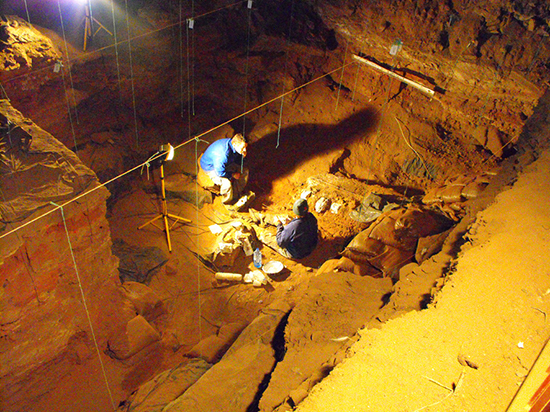Latest News Archive
Please select Category, Year, and then Month to display items
05 June 2018
Photo Supplied
 Archaeological excavations in the Wonderwerk Cave, north of Kuruman in the Northern Cape.
Archaeological excavations in the Wonderwerk Cave, north of Kuruman in the Northern Cape.
Research fellow Dr Lloyd Rossouw from the Department of Plant Sciences at the University of the Free State (UFS) recently published an article in the Nature Ecology and Evolution journal with Dr Michaela Ecker from the University of Toronto as lead author, and Dr James Brink, research fellow at the UFS Centre for Environmental Management. The findings described in “The palaeoecological context of the Oldowan-Acheulean in southern Africa” provides the first extensive paleoenvironmental sequence for the interior of southern Africa by applying a combination of methods for environmental reconstruction at Wonderwerk Cave, which have yielded multiple evidence of early human occupation dating back almost two million years ago.
Where water once was
The Wonderwerk Cave is found north of the Kuruman hills (situated in Northern Cape) a 140m long tube with a low ceiling. The surroundings are harsh. Semi-arid conditions allow for the survival of only hardy bushes, trees, and grasses. But during the Early Pleistocene, stepping out of the Wonderwerk Cave you would have been greeted by a completely different site, the researchers found. Using carbon and oxygen stable isotope analysis on the teeth of herbivores (Dr Ecker), fossil faunal abundance (Dr Brink), as well as the analysis of microscopic plant silica remains (phytoliths) excavated from fossil soils inside the cave (Dr Rossouw), the results show that ancient environments in the central interior of southern Africa were significantly wetter and housed a plant community unlike any other in the modern African savanna.
What difference does it make?
While East African research shows increasing aridity and the spread of summer-rainfall grasslands more than a million years ago, the results from this study indicate an interesting twist. During the same period, shifts in rainfall seasonality allowed for alternating summer and winter-rainfall grass occurrences coupled with prolonged wetlands, that remained major components of Early Pleistocene (more or less the period between one and two million years ago) environments in the central interior of southern Africa. That means our human ancestors were also living and evolving in environments other than the generally accepted open, arid grassland model.
Inter-religion Forum established at UFS
2010-05-28
 |
Persons who attended the founding meeting are, from the left, front: Mr Sunil Poken (representative from the Hindu religion), Ms Ria Paz (Jewish religion), Mr Ronnie Rosen (Jewish religion); back: Rev. Nic Schmidt (Christian), Mr Misaac Davids (Bah'ai religion), Mr Douglas Henney (Bah'ai religion), Rev. Maniraj Sukdaven (Christian religion), and Mr Kebra Melkitsedek (Rastafarian religion).
|
| An Inter-religion Forum (IRF) was established by Rev. Manirjaj Sukdaven, Head of the Department Religion Studies at the University of the Free State (UFS). Representatives from different religions were invited to the founding meeting of the IRF. Religions that showed interest to become involved in the IRF include, amongst others, Ba’hai, Rastafarians, Jews, Hindus, Muslims, Buddhists en New Age followers. The IRF will, amongst others, assist in the compilation of course material about different religions. The forum has also arranged a series of meetings where representatives of different religions discussed the question, “Why am I here?” This is the first forum of this nature at a tertiary institution in South Africa. |